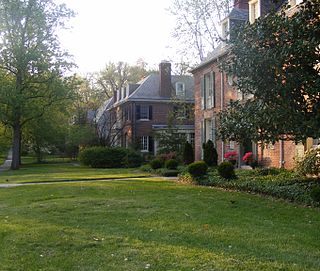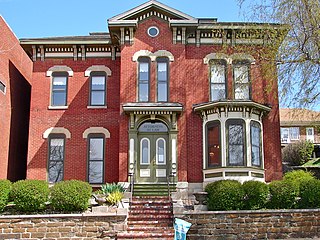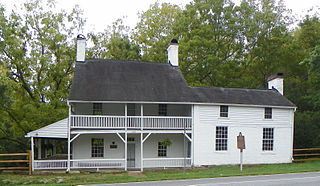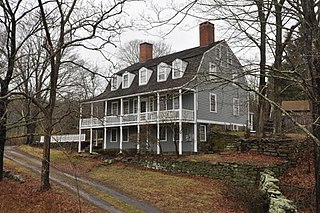
Central House is an 1860s hotel building located in the 800-person village of Orangeville, in Stephenson County, Illinois, United States. The building was built by Orangeville founder John Bower and operated as a hotel from its construction until the 1930s, when it was converted for use as a single family residence. The three-story building was the first commercial brick structure in downtown Orangeville. Architecturally, the building is cast in a mid-19th-century Italianate style. Central House was added to the U.S. National Register of Historic Places in 1999.

Guilford is a prominent and historic neighborhood located in the northern part of Baltimore, Maryland. It is bounded on the south by University Parkway, on the west by North Charles Street, Warrenton and Linkwood Roads, on the north by Cold Spring Lane and on the east by York Road. The neighborhood is adjacent to the neighborhoods of Tuscany-Canterbury, Loyola-Notre Dame, Kernewood, Wilson Park, Pen Lucy, Waverly Oakenshawe, Charles Village, and the universities of Johns Hopkins and Loyola University Maryland. The neighborhood was added to the National Register of Historic Places in 2001.

Guilford is a large country farmhouse near Frederick, Maryland, built in 1809. Formerly the center of a 103-acre (0.42 km2) farm, the brick house retains many of its outbuildings despite its location in the middle of a suburban shopping and office development.

The Jerathmell Bowers House is a historic house, built circa 1673, at 150 Wood Street in Lowell, Massachusetts. It is the oldest known home in Lowell. It was listed on the National Register of Historic Places in 1994.

The Griswold House is a historic house museum at 171 Boston Street in Guilford, Connecticut. Built about 1764, it is a well-preserved example of New England colonial architecture, and was listed on the National Register of Historic Places in 1975. The Guilford Keeping Society operates the house as the Thomas Griswold House Museum. The museum includes the late 18th century period New England saltbox house, a historic blacksmith shop, a barn with farm tools and implements, two corn cribs and a Victorian era three seat outhouse. The museum is open seasonally from June through October on a limited number of days each week.

Home Farm, also known as the Mirriam-Bartholomew House, is a historic home and farm complex located at East Whitehall in Washington County, New York. The house was built about 1840 and consists of a two-story, five bay, center entrance brick main block with a rear brick kitchen wing in the Greek Revival style. The farm complex has 17 contributing resources including a frame cow barn complex, a timber frame horse and carriage barn, a light frame creamery, a light-frame sugar house, and a brick smoke house.

The McManus House is a historic building located in the West End of Davenport, Iowa, United States. It has been listed on the National Register of Historic Places since 1983.

The Kimball–Stevenson House is a historic building located just north of downtown Davenport, Iowa, United States. It was built in 1873 and it has been listed on the National Register of Historic Places since 1983.

The John R. Boyle House was a historic building located on the east side of Davenport, Iowa, United States. It was listed on the National Register of Historic Places in 1983, and has subsequently been torn down.

The Westphal–Schmidt House is a historic building located in the West End of Davenport, Iowa, United States. The residence has been listed on the National Register of Historic Places since 1984.

The Robert Sands Estate was a historic home located at Rhinebeck, Dutchess County, New York. The house was built about 1796 and is a 2 1⁄2-story, brick filled wood frame building, with a gable roof and sheathed in clapboard. It sat on an extant stone foundation and measured five bays wide by four deep. Also on the property were a contributing 1 1⁄2-story frame cottage and four frame farm outbuildings, including a Dutch barn.

The Hancock County Courthouse is located in Garner, Iowa, United States. It was listed on the National Register of Historic Places in 1981 as a part of the County Courthouses in Iowa Thematic Resource. The courthouse is the second structure to house court functions and county administration.

Guilford is a historic plantation house and a farm located near White Post, Clarke County, Virginia. It was built between 1812 and 1820, and is a two-story, nearly square, brick dwelling with a hipped roof in the Greek Revival style. The front facade features a full-height, three-bay, pedimented portico with monumental Greek Ionic order columns. Also on the property is a contributing brick slave's quarters.

Richard Mendenhall Homeplace and Buildings a historic homeplace, farm and buildings in the Southeastern United States located at Jamestown, Guilford County, North Carolina. The Mendenhall farmhouse was built in 1811, and consists of a two-story, brick main block of plain typically Quaker design, with a porch on three sides and a number of additions to the west and rear. Also on the property is a large early Red Bank Barn of the Pennsylvania German type, Underground Railroad False Bottom Wagon, One Room School House, Dr. Madison Lindsay's House, Museum, Thy Store, and a Well House.

Model Farm, also known as Swarthmore Farm, is a historic home located at High Point, Guilford County, North Carolina. It was built about 1867, and is a 2 1/2-story, triple-A roofed, side-gabled, L-plan, frame building with 12 rooms. It is sheathed in weatherboard and sits on a brick foundation. The front facade has a full width, one-story hip-roofed porch. The house is associated with an important program of the Quakers to improve agricultural endeavors in the South in the decades after the American Civil War.

Joel Jessup Farm is a historic home and farm located in Guilford Township, Hendricks County, Indiana. The farmhouse was built about 1864, and is a two-story, Italianate style brick I-house with a rear kitchen ell. It has a slate gable roof, round arched windows, and multiple brick chimneys. Also on the property are the contributing traverse frame barn and privy.

Kellum–Jessup–Chandler Farm is a historic home and farm located in Guilford Township, Hendricks County, Indiana. The farmhouse was built about 1862, and is a two-story, central passage plan, brick I-house with Greek Revival style design elements. It has a gable roof, two-story rear ell, and sits on a brick foundation. Also on the property are the contributing three traverse frame barns, brick smokehouse, privy, chicken house, dairy barn, milk house, corn crib, and tractor shed.

The Decker House Hotel is a historic building located in Maquoketa, Iowa, United States. James Decker, an entrepreneur from Watertown, New York held numerous real estate holdings in and around Maquoketa. He built the first Decker House, a frame structure, in 1856. After Maquoketa was named the county seat in 1873, Decker decided to replace it. The three-story, brick, Italianate building was designed by Watertown architect W.W. Tucker. Its decoration is limited to the north and east elevations. Noteworthy, is its metal cornice and window hoods. It opened in May 1878, and it had two other competitors in town at that time. Following his death in 1881, James Decker's son Leonard took over his holdings in New York and Iowa. He moved into the Decker House in 1885 and died there in 1900. The building has subsequently lost its entrance porch, original front doors and the pediment over the cornice. It was listed on the National Register of Historic Places in 1978.

The Medad Stone Tavern is a historic house museum at 191 Three Mile Course in Guilford, Connecticut. Built in 1803 but never actually used as a tavern, it is well-preserved example of early 19th-century Federal period architecture. It is now maintained as a museum by a local historical society. It was listed on the National Register of Historic Places in 2009.

Bowerstown is an unincorporated community in Washington Township, Warren County, New Jersey near the Morris Canal and the Pohatcong Creek. It was founded in 1829 by Jesse Vanetta and Michael B. Bowers with the building of an iron foundry. The Bowerstown Historic District, encompassing the village, was listed on the state and national registers of historic places in 1996.























